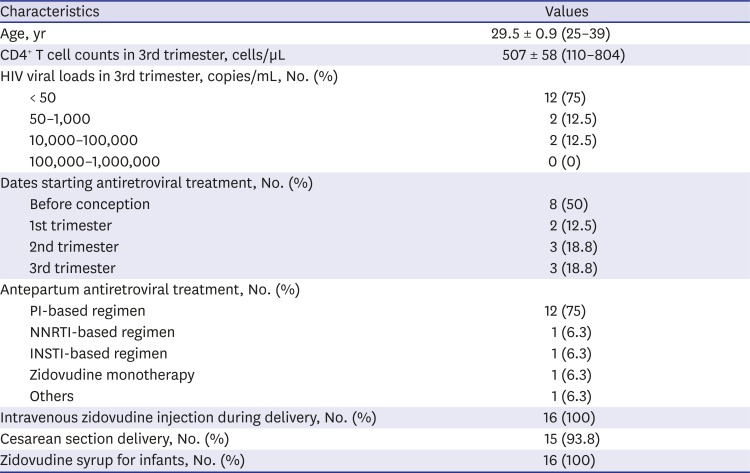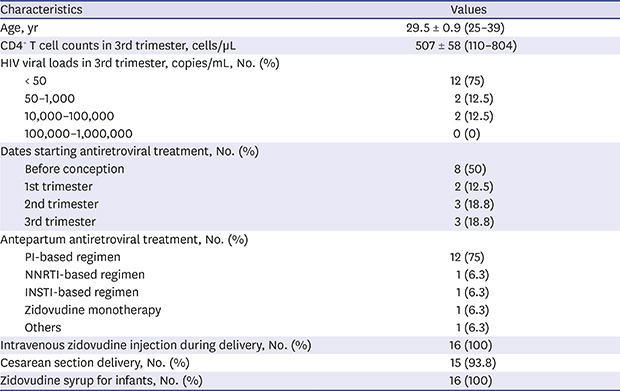1. Townsend CL, Cortina-Borja M, Peckham CS, de Ruiter A, Lyall H, Tookey PA. Low rates of mother-to-child transmission of HIV following effective pregnancy interventions in the United Kingdom and Ireland, 2000–2006. AIDS. 2008; 22(8):973–981. PMID:
18453857.

2. Nesheim S, Taylor A, Lampe MA, Kilmarx PH, Fitz Harris L, Whitmore S, et al. A framework for elimination of perinatal transmission of HIV in the United States. Pediatrics. 2012; 130(4):738–744. PMID:
22945404.

3. Govender T, Coovadia H. Eliminating mother to child transmission of HIV-1 and keeping mothers alive: recent progress. J Infect. 2014; 68(Suppl 1):S57–62. PMID:
24139190.

4. Brocklehurst P, French R. The association between maternal HIV infection and perinatal outcome: a systematic review of the literature and meta-analysis. Br J Obstet Gynaecol. 1998; 105(8):836–848. PMID:
9746375.

5. Kim HY, Kasonde P, Mwiya M, Thea DM, Kankasa C, Sinkala M, et al. Pregnancy loss and role of infant HIV status on perinatal mortality among HIV-infected women. BMC Pediatr. 2012; 12:138. PMID:
22937874.

6. Malaba TR, Phillips T, Le Roux S, Brittain K, Zerbe A, Petro G, et al. Antiretroviral therapy use during pregnancy and adverse birth outcomes in South African women. Int J Epidemiol. 2017; 46(5):1678–1689. PMID:
29040569.

7. Seol YM, Rheu EK, Park SE, Kim GH, Lee SH, Kwak IS, et al. Prevention of Mother-to-child Transmission of HIV: experiences from an University Teaching Hospital. Infect Chemother. 2007; 39(2):95–99.
8. Park JW, Yang TW, Kim YK, Choi BM, Kim HJ, Park DW. Ten years of experience in the prevention of mother-to-child human immunodeficiency virus transmission in a university teaching hospital. Korean J Pediatr. 2014; 57(3):117–124. PMID:
24778693.

9. Korea Centers for Disease Control and Prevention. Annual Report on the Notified HIV/AIDS in Korea 2015. Cheongju: Korea Centers for Disease Control and Prevention;2016.
10. Lim JS, Lim SW, Ahn JH, Song BS, Shim KS, Hwang IT. New Korean reference for birth weight by gestational age and sex: data from the Korean Statistical Information Service (2008–2012). Ann Pediatr Endocrinol Metab. 2014; 19(3):146–153. PMID:
25346919.

11. Massad LS, Springer G, Jacobson L, Watts H, Anastos K, Korn A, et al. Pregnancy rates and predictors of conception, miscarriage and abortion in US women with HIV. AIDS. 2004; 18(2):281–286. PMID:
15075546.

12. Wedi CO, Kirtley S, Hopewell S, Corrigan R, Kennedy SH, Hemelaar J. Perinatal outcomes associated with maternal HIV infection: a systematic review and meta-analysis. Lancet HIV. 2016; 3(1):e33–e48. PMID:
26762992.

13. Huntington SE, Thorne C, Bansi LK, Anderson J, Newell ML, Taylor GP, et al. Predictors of pregnancy and changes in pregnancy incidence among HIV-positive women accessing HIV clinical care. AIDS. 2013; 27(1):95–103. PMID:
22713479.

14. Myer L, Carter RJ, Katyal M, Toro P, El-Sadr WM, Abrams EJ. Impact of antiretroviral therapy on incidence of pregnancy among HIV-infected women in Sub-Saharan Africa: a cohort study. PLoS Med. 2010; 7(2):e1000229. PMID:
20161723.

16. Pilecco FB, Teixeira LB, Vigo A, Dewey ME, Knauth DR. Lifetime induced abortion: a comparison between women living and not living with HIV. PLoS One. 2014; 9(4):e95570. PMID:
24752119.

17. World Health Organization. Global Guidance on Criteria and Processes for Validation: Elimination of Mother-To-Child Transmission of HIV and Syphilis Monitoring. Geneva: World Health Organization;2014.
18. Chung SH, Choi YS, Bae CW. Changes in neonatal epidemiology during the last 3 decades in Korea. Neonatal Med. 2013; 20(3):249–257.

19. Short CE, Douglas M, Smith JH, Taylor GP. Preterm delivery risk in women initiating antiretroviral therapy to prevent HIV mother-to-child transmission. HIV Med. 2014; 15(4):233–238. PMID:
24025074.

20. Watts DH, Williams PL, Kacanek D, Griner R, Rich K, Hazra R, et al. Combination antiretroviral use and preterm birth. J Infect Dis. 2013; 207(4):612–621. PMID:
23204173.

21. Uthman OA, Nachega JB, Anderson J, Kanters S, Mills EJ, Renaud F, et al. Timing of initiation of antiretroviral therapy and adverse pregnancy outcomes: a systematic review and meta-analysis. Lancet HIV. 2017; 4(1):e21–e30. PMID:
27864000.

22. Chen JY, Ribaudo HJ, Souda S, Parekh N, Ogwu A, Lockman S, et al. Highly active antiretroviral therapy and adverse birth outcomes among HIV-infected women in Botswana. J Infect Dis. 2012; 206(11):1695–1705. PMID:
23066160.

23. Mugabo P, Els I, Smith J, Rabie H, Smith P, Mirochnick M, et al. Nevirapine plasma concentrations in premature infants exposed to single-dose nevirapine for prevention of mother-to-child transmission of HIV-1. S Afr Med J. 2011; 101(9):655–658. PMID:
21920159.


 ), and it is considered to be eliminated by World Health Organization (WHO) criteria.17
), and it is considered to be eliminated by World Health Organization (WHO) criteria.17




 PDF
PDF Citation
Citation Print
Print





 XML Download
XML Download